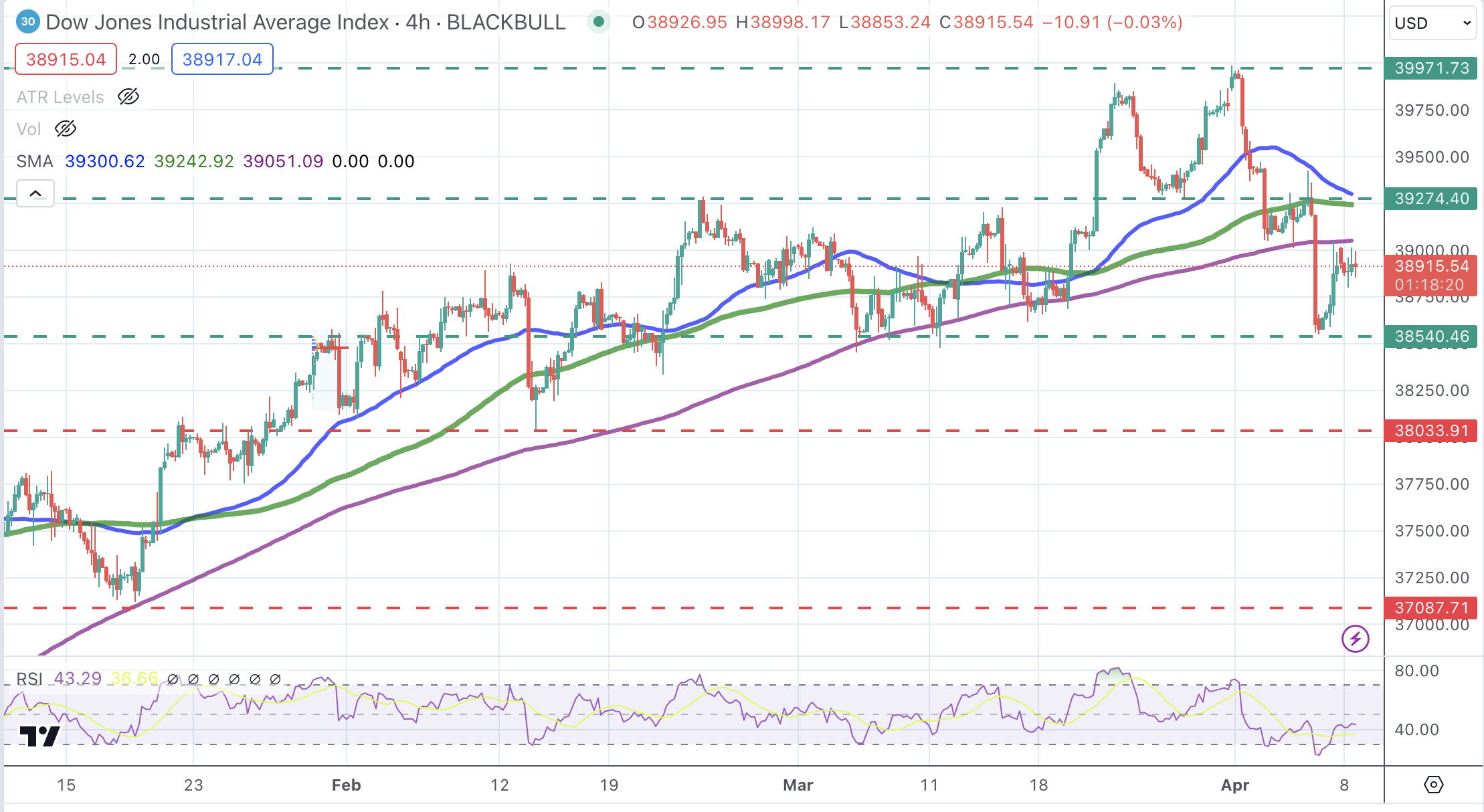- Analytics
- News and Tools
- Market News
- Dow Jones Industrial Average ticks up in calm weekly opening
Dow Jones Industrial Average ticks up in calm weekly opening
- Wall Street opens the week with marginal gains with investors relieved by decline in Oil prices.
- Dow Jones treads water near 39,000 level as rebound from Friday’s high stalls.
- Bias remains skewed to the downside with all eyes on Wednesday’s US CPI figures.
The Dow Jones Industrial Average (DJIA) has opened the week with minor advances, favoured by some risk appetite. Oil prices have retreated from multi-month highs as tensions in the Middle East ease somewhat, which has provided some relief to equity investors on Monday.
The market, however, is in a wait-and-see mode with traders reluctant to take excessive risks ahead of Wednesday’s US Consumer Prices Index data. US Inflation is expected to have accelerated to 3.4% in March from the 3.2% yearly rate in February, although core CPI is seen cooling to 3.7% from a 3.8% annual reading in the previous month.
All the main Wall Street indices are positive on Monday. The NASDAQ is leading with a 0.1% advance to 16,267, while the S&P 500, at 5,206, and the Dow Jones, at 38,913, post marginal gains.
Dow Jones news
Down to sectors, Consumer Discretionary is leading gains with a 0.8% advance, followed by Real Estate, which is up 0.5%. At the bottom of the ranking on Monday is the Health sector, dropping by 0.48%, and Energy, 0.32% below Friday’s close.
Nike (NKE) is the best Dow performer on Monday with a 1.42% increase to $90.11, followed by 3M (MMM) gaining 0.97% to $91.90. On the losing end, Merck (MRK) drops 1.5% to $126.02, and Intel (INTL) takes a further 1.2% decline to $38.25.
Dow Jones technical outlook
The Dow Jones index is trading practically flat with oscillators showing a lack of clear direction. The DJIA is still in a bearish correction from the 39,986 historic high hit in late March.
The recovery attempt from Friday’s lows has stalled below previous lows, at the 39,00 area, and with a supply zone at the 39,250 area likely to offer significant resistance. On the downside, the 38,540 level is still in play and might be revisited if US CPI posts a positive surprise on Wednesday. Below here, 38,035 would be exposed.
Dow Jones Index 4-Hour Chart

Inflation FAQs
Inflation measures the rise in the price of a representative basket of goods and services. Headline inflation is usually expressed as a percentage change on a month-on-month (MoM) and year-on-year (YoY) basis. Core inflation excludes more volatile elements such as food and fuel which can fluctuate because of geopolitical and seasonal factors. Core inflation is the figure economists focus on and is the level targeted by central banks, which are mandated to keep inflation at a manageable level, usually around 2%.
The Consumer Price Index (CPI) measures the change in prices of a basket of goods and services over a period of time. It is usually expressed as a percentage change on a month-on-month (MoM) and year-on-year (YoY) basis. Core CPI is the figure targeted by central banks as it excludes volatile food and fuel inputs. When Core CPI rises above 2% it usually results in higher interest rates and vice versa when it falls below 2%. Since higher interest rates are positive for a currency, higher inflation usually results in a stronger currency. The opposite is true when inflation falls.
Although it may seem counter-intuitive, high inflation in a country pushes up the value of its currency and vice versa for lower inflation. This is because the central bank will normally raise interest rates to combat the higher inflation, which attract more global capital inflows from investors looking for a lucrative place to park their money.
Formerly, Gold was the asset investors turned to in times of high inflation because it preserved its value, and whilst investors will often still buy Gold for its safe-haven properties in times of extreme market turmoil, this is not the case most of the time. This is because when inflation is high, central banks will put up interest rates to combat it. Higher interest rates are negative for Gold because they increase the opportunity-cost of holding Gold vis-a-vis an interest-bearing asset or placing the money in a cash deposit account. On the flipside, lower inflation tends to be positive for Gold as it brings interest rates down, making the bright metal a more viable investment alternative.
© 2000-2024. All rights reserved.
This site is managed by Teletrade D.J. LLC 2351 LLC 2022 (Euro House, Richmond Hill Road, Kingstown, VC0100, St. Vincent and the Grenadines).
The information on this website is for informational purposes only and does not constitute any investment advice.
The company does not serve or provide services to customers who are residents of the US, Canada, Iran, The Democratic People's Republic of Korea, Yemen and FATF blacklisted countries.
Making transactions on financial markets with marginal financial instruments opens up wide possibilities and allows investors who are willing to take risks to earn high profits, carrying a potentially high risk of losses at the same time. Therefore you should responsibly approach the issue of choosing the appropriate investment strategy, taking the available resources into account, before starting trading.
Use of the information: full or partial use of materials from this website must always be referenced to TeleTrade as the source of information. Use of the materials on the Internet must be accompanied by a hyperlink to teletrade.org. Automatic import of materials and information from this website is prohibited.
Please contact our PR department if you have any questions or need assistance at pr@teletrade.global.















